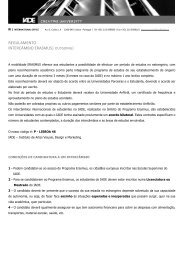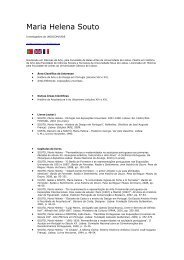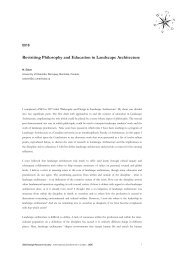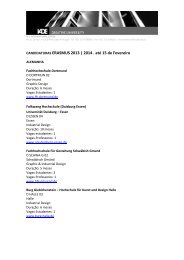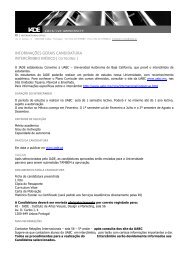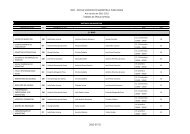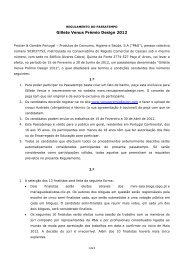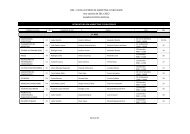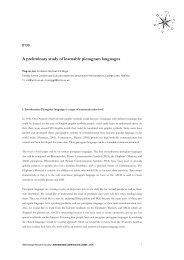0053 Conventions of Typography Related to Traditional Poetry - IADE
0053 Conventions of Typography Related to Traditional Poetry - IADE
0053 Conventions of Typography Related to Traditional Poetry - IADE
You also want an ePaper? Increase the reach of your titles
YUMPU automatically turns print PDFs into web optimized ePapers that Google loves.
(1890) only mention poetry when describing the work <strong>of</strong> the composi<strong>to</strong>r. Some manuals do not mention<br />
poetry at all, such as Caleb S<strong>to</strong>wer’s The printer’s manual (1817), T.C. Hansard’s Typographia (1825), Charles<br />
Henry Timperley’s Printer’s manual (1838), the American manual <strong>of</strong> printing: Typographia: or the printer’s instructions<br />
written by Thomas Adams and published in 1844, Thomas Lynch’s The printer’s manual (1859) and Thomas<br />
Mackellar’s The American printer: a manual <strong>of</strong> typography (1870). There are exceptions, such as W.H. Tickle’s The<br />
printers’ manual (1828) in which poetry is mentioned in the section on ‘capitalization’. Here, Tickle lists the<br />
situations in which capitals should be used. Situation number nine states: ‘9. At the beginning <strong>of</strong> every line <strong>of</strong><br />
poetry’ (Tickle, 1828:20). Another exception is found in the Manuel typographique written by Pierre-Simon<br />
Fournier in 1764. Here he shows a condensed typeface which he created especially for poetry. In the<br />
description <strong>of</strong> the characteristics <strong>of</strong> this condensed typeface, he states the importance <strong>of</strong> shortening the lines in<br />
order <strong>to</strong> avoid turnover lines:<br />
Another advantage <strong>of</strong> thus compressing the letters laterally against one another is that<br />
verse lines <strong>of</strong> ten or twelve syllables are not <strong>to</strong>o long for the page, and there is no need<br />
<strong>to</strong> make two lines <strong>of</strong> them, or, as it is called, turn them in.<br />
(Translated from French in<strong>to</strong> English in Carter, 1973:170)<br />
He emphasizes that the excess <strong>of</strong> turnover lines creates blocks <strong>of</strong> white on the page which are reinforced by<br />
the blank space already left by lines which do not extend the full width <strong>of</strong> the page, which a common<br />
characteristic <strong>of</strong> poetry. He says that these blocks are <strong>of</strong>fensive <strong>to</strong> the eye. He stresses that ‘the new type<br />
prevents this eyesore’ (Carter, 1973:170).<br />
The twentieth-century manuals<br />
By the twentieth century manuals <strong>of</strong> style had developed from these printers’ manuals. They were useful not<br />
only <strong>to</strong> printers, but also <strong>to</strong> authors. However, during this period <strong>of</strong> development, some <strong>of</strong> the printer’s<br />
manuals and manuals <strong>of</strong> style gave a similar lack <strong>of</strong> information about poetry: Henry Kenyon Stephenson’s<br />
Printing (1941), Thwaites’s Printers publishers authors handbook (1948), James Jarret’s Printing style for authors,<br />
composi<strong>to</strong>rs and readers (1960) do not mention poetry at all.<br />
In 1893, Horace Hart wrote a manual for composi<strong>to</strong>rs and readers called Hart’s rules. This work developed in<strong>to</strong><br />
the manual <strong>of</strong> style <strong>of</strong> The Oxford University Press, The Oxford guide <strong>to</strong> style. In the Hart’s rules editions from<br />
1893 until the late twentieth century, more space is gradually devoted <strong>to</strong> poetry, although the greatest space is<br />
still related <strong>to</strong> how <strong>to</strong> quote poetry within prose texts. The field <strong>of</strong> prose is without doubt the main focus <strong>of</strong><br />
interest. However, some manuals <strong>of</strong> style from the twentieth century and some books about editing do<br />
mention poetry in more detail, such as R.A. Hewitt’s Style for print and pro<strong>of</strong> correcting (1957), Marjorie Skillin and<br />
Robert Gay’s Words in<strong>to</strong> type (1974), Judith Butcher’s Copy-editing (1992), The Chicago manual <strong>of</strong> style (1993) and<br />
Ritter’s Oxford guide <strong>to</strong> style (2002). Books or articles about typography, composition and his<strong>to</strong>rical aspects <strong>of</strong><br />
writing and typography have also devoted some space <strong>to</strong> poetry such as De Vinne’s Correct composition (1902),<br />
Bernard Newdigate’s On printing poetry (Thorpe, 1950), Oliver Simon’s Introduction on typography (1945), Norman<br />
Hidden’s The poet’s guide (1979), Jan Tschichold’s Asymmetric typography (1967), Hugh Williamson’s Methods <strong>of</strong> book<br />
design (1956), Ullman’s Ancient writing and its influence (1963), Ruari McLean’s Manual <strong>of</strong> typography (1980), Robert<br />
Bringhurst The elements <strong>of</strong> typographic style (1992), M.B. Parkes’ Pause and effect: punctuation on the west (1992) and<br />
2006 Design Research Society . International Conference in Lisbon . <strong>IADE</strong> 2





